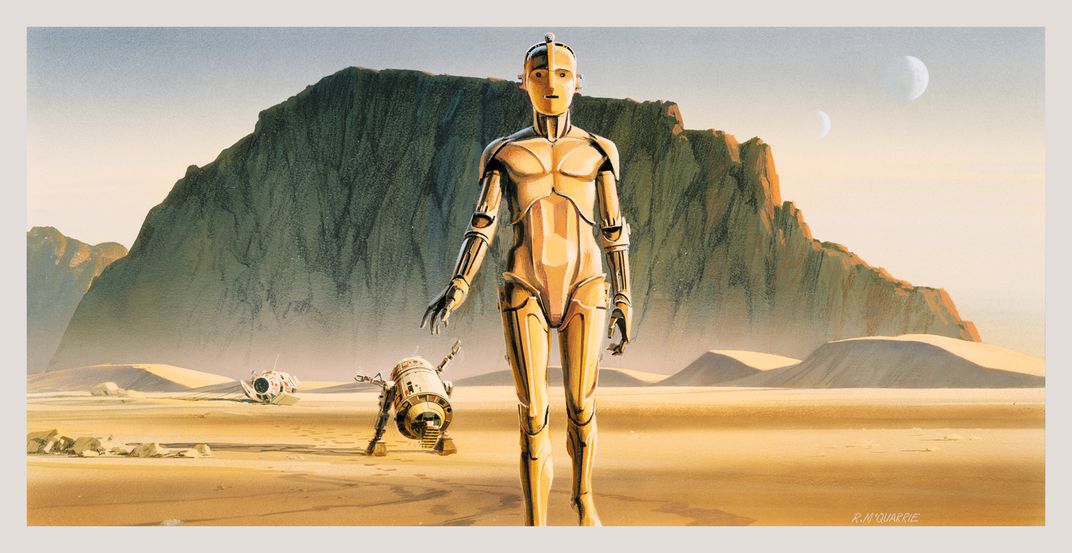Did you hear that? They shut down the main reactors. We’ll be destroyed for sure. This is madness!”
The first line spoken in the first Star Wars movie 40 years ago was delivered by a fussy android with a plummy pan-British accent. Since then, C-3PO—returning to the screen in The Last Jedi— has been bought, sold, blasted, dismantled, dismembered, imprisoned, exploded, rebuilt, rebooted and made an Ewok god. He is the expressionless and instantly recognizable gold-plated face of the franchise. Head tipped just so, shuffling like a geisha, he arrived onscreen as a quantum upgrade to Robby the Robot by way of P.G. Wodehouse.
He has always and only ever been played in the movies by the actor Anthony Daniels.
The first thing you notice about C-3PO (a costume from 1983’s Return of the Jedi resides in the Smithsonian National Museum of American History) is the unblinking lantern eyes set below sculpted brows. Then the hyphen of the mouth beneath the brush stroke of a nose. Like something out of kabuki or bunraku, Daniels says, “it’s a wonderful blank, beautiful mask that you can put, place an emotion on.” He plays it that way, indicating emotions by posture alone, the angle of the chin, the poise of the fingertips.
Programmed to serve but never servile, C-3PO is a “protocol droid” fluent in seven million languages, a courtier ever diplomatic and acutely aware of himself in the political and practical moment. Often frightened to fine comic effect, he is just as often a reluctant hero. “He absolutely isn’t cowardly,” Daniels will tell you politely. “He is self-preservational. He knows what danger is about, and why would you not run from danger? Why would you not try and prevent people running into danger?”
In 1976 Daniels was appearing in a London stage production of Rosencrantz and Guildenstern Are Dead and was determined not to take a job on a trivial sci-fi film. Then he saw Ralph McQuarrie’s concept sketch for C-3PO. He saw something in that face. The first three Star Wars films (1977, 1980, 1983), all narrative drive and swashbuckle, still hold up. Fast-paced and funny, they repackaged an archetypal quest for revenge and reconciliation as an outer space western. Good versus evil, dark against light. Simple. R2-D2 and C-3PO are the mismatched comic relief, an intergalactic Odd Couple as Greek chorus: Threepio the neatnik Felix to R2’s slovenly Oscar, reminding the audience what’s at stake and how the principals really feel.
“You need a balance of elements in all these films. It’s a fairy story, it’s a romp. So there’s serious bits, the dangerous bits, whatever, and then occasionally the refreshment of a character who doesn’t really fit into the environment,” Daniels says. “That was another brilliance of George [Lucas], that you come back to the protocol and etiquette thing, these are the last skills ever to be required in a horrible desert surrounded by ghastly people.”
Still, C-3PO translates it all, not only into English, but into a series of unheroic, recognizably human responses. Worry. Fear. Joy. Sadness. Onscreen, he is us. “We seem to be made to suffer. It’s our lot in life,” the droid says in that first long-ago movie. What could be more human?



A low-budget, low-expectations success story, that original trilogy is now as canonical to its core fans as anything from Sophocles or John Ford.
When not busy with the sacred franchise, Daniels is a visiting scholar at Carnegie Mellon University’s Entertainment Technology Center, talking futurism and tech and hardware and software with students. Forty years ago, robots were a thrilling part of an uncomplicated science fiction future. Now they’re part of a darker revolution onscreen and off in which machines take over entire sectors of the world economy, leaving humans to languish. Thus does the world’s most famous android and the man who plays him meet in the moment of our suddenly complicated relationship with automation. When the robot comes for your job, will that beautiful face look so benign?
Fully human Harrison Ford earns his living these days reprising his roles as Han Solo or Indiana Jones or Rick Deckard. He is busy acting his age. Like Ford, Anthony Daniels has seen the years advance as he has played one of the most recognizable characters on the planet. But you wouldn’t know it. The mask is ageless. Still slender enough to fit the suit at 71; still in possession of that wonderful voice.
“Have I ever thought of retiring? Yes, I have thought about it. Am I going to? No.”
One day not too far, far away, even this robot will be automated out of a job, and C-3PO will be rendered by a computer. Still, he can be played only one way. The way Anthony Daniels plays him.

Subscribe to Smithsonian magazine now for just $12
This article is a selection from the December/January issue of Smithsonian magazine





